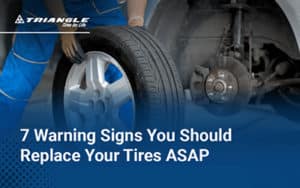You may often focus on routine maintenance, fuel efficiency, and safe driving practices when caring for your car. However, dry steering is one commonly overlooked bad driving habit that can significantly impact your vehicle’s condition. While it may seem like a minor issue, dry steering can cause substantial damage to your tires, steering system, and suspension.
In this article, you’ll learn what dry steering is, how it can affect your vehicle’s components and overall performance, and how to prevent it.
What is Dry Steering?
Dry steering refers to turning the steering wheel while the vehicle is stationary. While it may be necessary for certain maneuvers, it can lead to accelerated wear and tear on the front tires. Maintaining good driving habits is essential for preserving the longevity and performance of your vehicle.
Why You Should Avoid Dry Steering
From wear and tear of tires to damage to auto components, dry steering can cause car safety problems.
Potentially damage the steering system
Dry steering can impact your vehicle’s steering system. The increased resistance and strain on the system can lead to premature wear of components such as the steering rack, tie rods, and joints, which can be costly in repairs.
Advances the wear and tear of tires
When you turn the steering wheel while the vehicle is stationary, the front tires experience excessive friction. This scenario can lead to accelerated wear and uneven tread. It can also indirectly affect the stability of the back tires.
May compromise a tire’s sidewall and rims
On its own, dry steering may not cause dramatic and immediate damage to your tires. However, the tire’s sidewall and the wheel’s rims may be damaged from the combination of the pressure applied by the hammer that is the vehicle’s power steering and the anvil that is the street’s curb. Driving maneuvers like parallel parking may be prone to this
How to Avoid Dry Steering
It’s in your best interest to follow best practices for avoiding dry steering. On top of the list is initiating slight vehicle motion before turning the steering wheel to prevent tire damage. Regular tire maintenance, including proper inflation and rotation, can also help mitigate wear caused by dry steering.
Avoid excessive steering
Avoiding excessive steering reduces the friction between the tires and the road, preventing unnecessary wear on the tires and reducing the strain on the suspension and steering system.
You might feel compelled to practice dry steering when parallel parking in a tight space, which is a mistake. Instead of forcefully turning the steering wheel back and forth while stationary, make smooth and controlled adjustments while moving slowly forward or backward.
Plan your turns in advance
Picture yourself approaching a sharp turn on a narrow street. Turning too quickly can wear out your tires quicker. By planning the turn, you can gradually reduce your speed and position your vehicle correctly in the lane ahead of time. This allows for a smoother turn without sudden and sharp steering. As you avoid dry steering, you ensure better vehicle control throughout the maneuver.
Use proper steering techniques
Instead of turning the steering wheel while the vehicle is stationary, initiate a slight forward or backward motion beforehand. For instance, if you need to make a sharp turn while parking, move slowly forward or backward to help ease the turn and minimize dry steering.
Choose suitable parking spaces
Whenever possible, select parking spots that provide ample space for maneuvering. Avoid tight areas or locations that require excessive steering in a stationary position. The goal is to allow yourself to move without excessive dry steering.
Only turn while in motion
Turning the steering wheel while in motion gives the best results. It reduces friction, preserves tire tread, minimizes strain on components, enables smoother maneuvering, and promotes safer driving conditions by avoiding potential damage and wear caused by dry steering.
You can incorporate this practice as a parking maneuver. For example, when reversing into a parking space, initiate backward motion first and gradually turn the wheel to guide the vehicle into position.
Smooth Turns, Happy Tires
Mastering the art of steering in motion is crucial for maintaining the health and longevity of your vehicle. By avoiding dry steering and implementing proper techniques like turning while in motion, you can reduce friction, preserve tire tread, minimize strain on components, and enjoy smoother maneuvering on the road. Remember, good driving habits lead to less wear and tear on your vehicle.
If you’re looking for quality tires, look no further than Triangle Tires. We offer durable tires from passenger cars and light trucks to heavy equipment vehicles. Our reliable delivery service also lets you enjoy the perfect tire solution for your daily road trips. Browse our tire catalog, or contact us for your tire needs.


